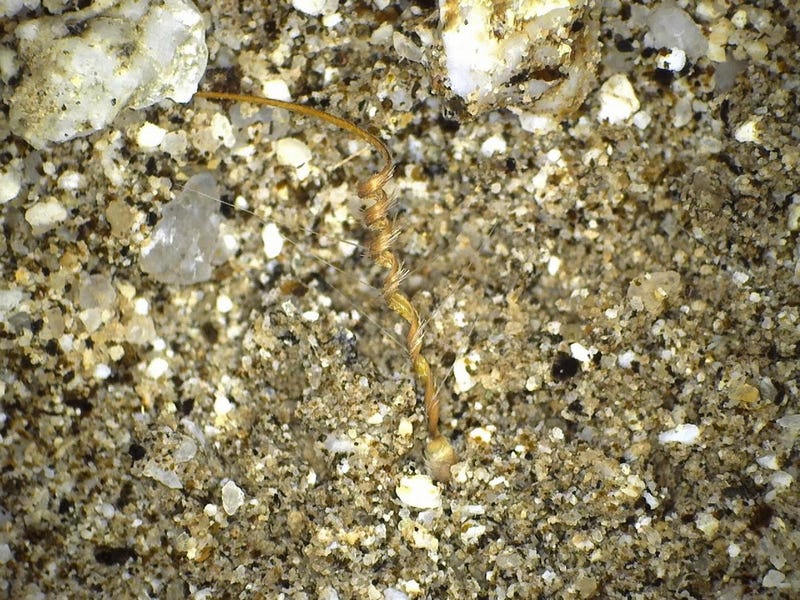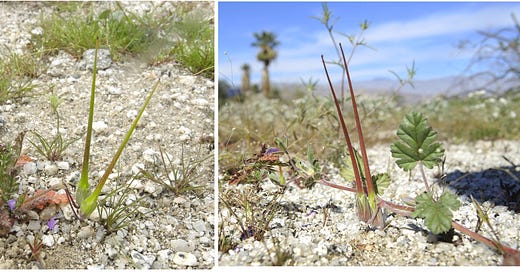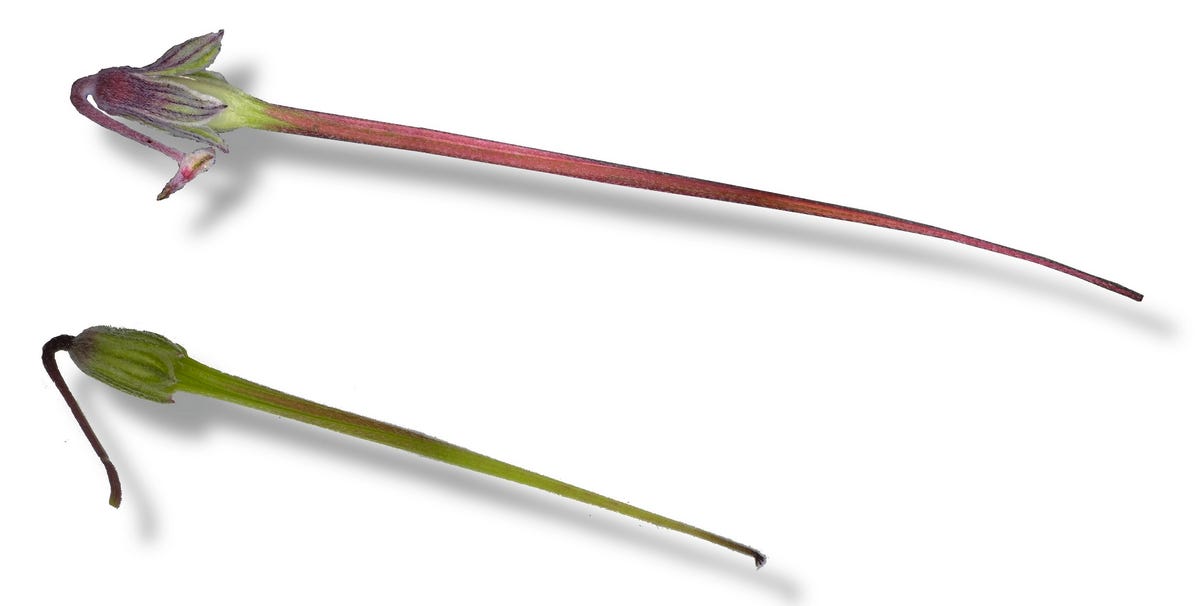Except when they are shaking in the wind, we don’t usually think of plants moving. Sure, there’s the Venus fly trap with its snapping leaves, but other insectivorous plants use passive rather than mouse-trap approaches. The opening and closing of flowers, the folding of leaves at night or in the hot sun are slow enough so that they don’t seem like real, honest-to-god movements, and what’s more, they are just parts of plants, not the whole thing.
But some plants do move, and rather fast too, if you accept that a seed is an entire plant (which it is…). The Found Object for this essay is thus rather small, and plentiful, and I have a lot of them. They are the seed heads and seeds of two species in the geranium family that grow in the American deserts, Erodium cicutarium and Erodium texanum. Each seed head carries five seeds and has a long pointy projection, clearly the inspiration for the common names storksbill and cranesbill, or sometimes the other way around. Of course, a lot of wading birds have pointy bills, so why not egretsbill, bitternsbill, sandpipersbill, godwitsbill or any number of other bills? I can see a fine game over a few beers emerging here...
The pointy seed heads hide some remarkable magic. The seeds are not free but are contained in the dried carpel in which they developed and are thus called an achene, rather than a seed, by botanists. The five achenes have long awns that surround a central core, each awn as narrow and linear as can be, all the way from its attachment to the seed to its pointy tip. When the seed head is ripe and begins to dry out, the long awns begin to contract and curl, pulling the seeds away from their attachments at the base. The curling occurs because the inside layer of the awn contracts more upon drying than does the outside layer, bending the awn, but this does not describe the real virtuosity of the process, for the direction of the contraction is at an angle to the long axis so that the awn contracts in a tight helical spiral when viewed from the end.


The cartoon below illustrates why the awns twist the way they do. The red inner layer contracts and swells far more than the black outer layer upon drying and wetting, creating a bending, twisting force. This is achieved by modifying the hygroscopic (water absorbing, holding) properties of the cellulose-lignin material making up the inner layer and outer layers, so that the inner layer shrinks and swells much more as water is gained and lost.

The prominent bristles and very long hairs on the outer surface of the awn all point in a clockwise direction as seen from the seed end. The seed too is covered with a dense coat of bristles, again all pointing in a clockwise direction. Why this elaborate arrangement? This consistent and intricate structure is part of a mechanism that allows the achenes to plant themselves into the ground.
Here is how they do it. The coiling through drying is almost completely reversible upon wetting. In the video below the seed is immovably mounted to show the rapid unwinding of the awn upon wetting (speeded up 15-fold), but also its rewinding as the seed dries again. This unwinding and winding can repeat for many cycles of drying and rewetting. In nature, it is probably rain or heavy dew that unwinds the awn.

By combining all the observations above, we come to the evolutionary reason for all this bristly winding, unwinding and rewinding. To understand how this works, imagine a dried, wound-up achene on the ground, a few centimeters from its natal plant where it has been tossed by explosive separation. Now picture what happens in the next rain, or the next heavy dew. The freshly wet awn uncoils in a counterclockwise direction, but its outer tip is on the ground and can’t move, so the seed spins and is drilled and pushed into the ground as the uncoiling spiral lengthens. The bristles on the awn and the seed all point in a clockwise direction, preventing reversal of the drilling motion, much like a ratchet on a wrench. Should the seed fail to plant successfully in one cycle, the awn rewinds to try again in the next wet-dry cycle. Given enough cycles, the seed is very likely to plant itself, and once planted, is more likely to succeed in germination and growth. This is a powerful agent of selection.

But nothing is sure-fire. In the Anza-Borrego desert where I collected these seeds, several species of harvester ants also collect them, not for their novel value like I did, but as food to store for harder times. The most abundant and efficient collector is the black harvester ant, Veromessor pergandei whose foraging columns can extend tens of meters across the desert, with thousands of workers carrying seeds back to the nest. There, nest workers clip off the useless (to them) awn and store the bereft seeds in underground chambers by the tens to hundreds of thousands. The discarded awns are trash dumped around their nest craters where it accumulates in dense mats. The ants and their insatiable appetite for seeds are probably a second agent of natural selection that led to the self-planting behavior--- escape from Death by Ants.

It may not seem like much--- a couple of inconspicuous species of weeds growing on the desert floor after a rain. Tiny violet flowers that shed their petals by the end of the day. Seed heads that develop rapidly, then dry out to pop apart, ejecting twisty objects that litter the desert floor, objects that, after the next rain, drive their seed underground before ants can collect them as food. Who would have guessed all the drama, action and motion wrapped up in that common plant with its mundane seed heads? Who would have considered how much a plant can accomplish by “simply” modifying the hygroscopic properties of the layers making up its awns? Who would have thought that while we are admiring the gaudy purple, yellow and white flowers of a desert annual bloom we are treading on a marvel so small, unassuming and surprising?






Wonderful glimpse into these tiny gems. Does the repeated winding/unwinding action occur without any expenditure of energy by the seed?
Fascinating! Thanks so much for sharing - and for the YouTube links that really bring it this process to life!